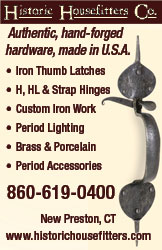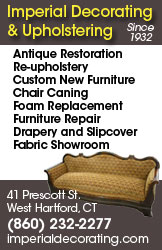Home
 Structural Products & Services, Stairlifts Structural Products & Services, Stairlifts Furniture, Clocks,
Accessories
Reclaimed Stone Materials
Woodwork, Blinds,
Finishing
Lighting
Kitchen
Floors & Rugs
Fabrics
Paint & Wallpaper Pottery & Tile
Period Hardware Antiques, Folk Art,
Fine Art, Auction Houses
Windows
Interior Design & Architecture
Silver, Cookware, Pewter
Garden
Historic Hotels |

RESTORING HISTORIC HOUSE IN GLASTONBURY AN UPWARDLY MOVING EXPERIENCE
by Peter Marteka,
Hartford Courant
Photos by Chris Gurshin

Old coins usually turn up in between couch cushions or under car seats. Or if you are renovating an old house, in the door frame of an 18th-century home.
During the removal of doors at the historic Thomas Hale Homestead, which dates back to the 1700s, workers found several pennies — an Irish Copper halfpenny dating to 1766 and a U.S. copper penny minted in 1787. Jonathan Russell, chairman of the building committee transforming the Main Street home into a new chapel at First Church of Chirist Congregational, said it was a common practice to bury a coin dated in the year the house was completed in a door frame.
"It was a penny designed by Benjamin Franklin," Russell said of the U.S. penny. "There are 13 concentric circles on the backside, but in the middle it says, 'We are one' for the 13 original colonies. On the other side of the coin is the Benjamin Franklin phrase 'mind your business' which I just love."
The coins are in poor condition and probably not worth much, but the pair of pennies are a few of the treasures workers have uncovered as they preserve the shell of the post and beam house that will become the Micah House and Chapel. The house has been stripped of windows, walls and floors and is jacked up several feet in the air awaiting a 21st-century concrete foundation. |

"Everyone who stops always asks why we are tearing down the house," he said. "We aren't. We are preserving what we can and incorporating it into a new building."
The new building will be located just south of the church and will be used for small weddings, funerals, music recitals, book signings as well as for community meetings.
The church has raised $950,000 for the project, but Russell noted over the past several months dozens of volunteers have helped remove the walls, plaster, flooring and donned environmental suits to remove lead paint from the home leading to more than 800 hours and $40,000 in sweat equity.
"The goal is to renovate and stabilize the old 1700s home and what's left of it," Russell said. "We've pulled off everything we can from the house and saved what we can...putting as much of the old trim, molding, paneling and flooring back in as we can ... our goal is to build something that will last another 250 years."

  
The flooring for the new building will be made from the huge chestnut planks that once served as the outer walls to the home. The boards will be sanded and planed. All the moulding and paneling has been painstakingly removed and labeled and the home's original nails have been saved.

Once everything was removed from the original post-and-beam structure, a house-moving company jacked up the house several feet and put it on steel beams and wooded pallets so a new foundation could be poured. The original brick-and-fieldstone foundation will be incorporated into a patio behind the new building. The home's center chimney and fireplace will be a focal point in the chapel design.
"The old post and beam is in great shape," said architect Brian Davis, who has designed numerous buildings across the state. "Everything is going along pretty smoothly. It's really been one of my favorite projects of all-time."
|
|




 


 

 
|














